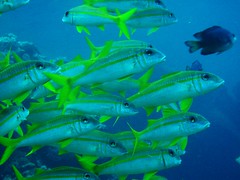
The people of the qoliqoli (fishing grounds) of the vanua Nabekavu, Dreketi, Macuata, Sasa and Mali have, in the past 2 years, implemented set actions for the use of their I qoliqoli.
They have successfully set aside 9 areas, totaling to 117 kms2 within the I qoliqoli as tabus(protected areas), for the purpose of restocking the I qoliqoli. Already, the people of the I qoliqoli are talking about larger fishes caught near shore as in the past and different types that had not been seen in the recent years have begun to come back.
- Emosi Baya, one of the I qoliqoli committee members from Nakawaga, Mali Island.
Currently WWF Fiji and partners are working with the Macuata communities by assisting in the development and implementation of resource management plan, educating and training of community members to undertake activities outlined in their management plans, training fish wardens and building community capacity (through household financial literacy training, community messaging, community biological and socio-economic surveyors etc).
With WWFs support to come to an end in three years, there is a commitment by WWF to assist the qoliqoli committee to secure funding with which the qoliqoli communities will continue to manage their I qoliqoli’s.
Long term self financing of Marine Protected Areas
A 12 month Fund Raising Plan (May 2007 to June 2008), with 4 activities, targeting FJD100,000, has been developed to generate funding for the management of the qoliqoli, spearheaded by the Qoliqoli Committee of the Vanua Nabekavu, Tikina Dreketi, Macuata, Sasa & Mali.
- Sanivalati Navuku, Project officers, WWF Fiji Programme
The first fundraising event is the upcoming Great Sea Reefs (GSR) Sevens Rugby Tournament, in November (9th to 10th) at the Subrail Park, in Labasa. The tournament targets to raise $15,000.00.
Ten top national teams will be invited to participate, with part of their travel and accommodation costs supported by the Qoliqoli Committee through sponsorship.
A total of 56 teams are expected to participate, including boys teams of 17, 16, 15, 12, 9. The inclusion of the boys team is expected to pull in parents and families to travel to the games venue in Labasa.
Mr. Baya who is involved in the fundraiser said,
Other fundraising activities by the Qoliqoli committee includes- Honorary Qoliqoli Owners by Invitation, targeting $9,000.00, Connecting qoliqoli members living outside of Fiji (3), targeting $10,000.00 and Village based fund raising & dinner by invitation, targeting $42,000.00.
- Sanivalati Navuku, Project officer, WWF Fiji.
Fiji’s precious marine ecosystem is under attack from over fishing, unsustainable and destructive harvesting of live coral and exotic fish for aquariums, and increasing levels of pollution. Climate change is also playing its part in the degradation of the marine environment as warmer sea water.
In November 2005, seven chiefs of the province of Macuata launched the first of the country’s networks of Marine Protected Areas (MPAs) on the Great Sea Reef, the third largest barrier reef in the world. This came about as a result of the Great Sea Reef survey, a first in the area, conducted in 2004 with the support of WWF and partners, which highlighted its unique biodiversity.
WWF has witnessed the benefits of MPAs to biodiversity and marine resources and the people who rely on them around the world. Hence it is supporting the Government and the people of Fiji in the development and implementation of its commitment to have 30%of the country’s EEZ under MPAs by 2020. Together with FLMMA and other key organisations, WWF is facilitating policy dialogue, scientific research, community capacity building and financing.
Source: WWF Fiji
















